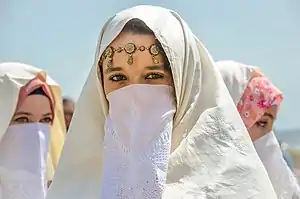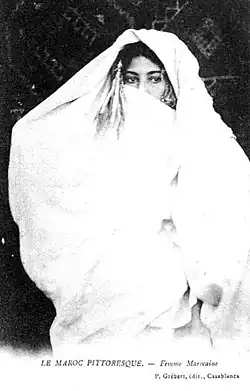Haik (garment)
The haik (Arabic: حايك) is a traditional women's garment worn in the Maghreb region.[1][2] It can be white or black, though is usually white. It consists of a rectangular fabric covering the whole body,[3] 6 by 2.2 metres (19.7 ft × 7.2 ft) in length, rolled up then held at the waist by a belt and then brought back to the shoulders to be fixed by fibulae.


| Part of a series on |
| Islamic female dress |
|---|
| Types |
| Practice and law by country |
| Concepts |
| Other |
Etymology
The word is borrowed from the Maghrebi Arabic word hayk, which comes from the Arabic verb haka which means "to weave". First used in French in the form heque (1654), it underwent many variations – hayque (1667), alhaic (1670), eque (1670), haic (1683), hayc (1686). The word haik in French was at first of the feminine gender (1725) and became masculine in 1830.[4]
Origins
The haik is of Arab-Andalusian origin,[5] and present throughout the Maghreb.[6][7] In 1792, the m'laya, a black veil, popular in the eastern part of Algeria, made its appearance to mourn Salah Bey, Bey of Constantine.[8] Made from wool, silk or synthetic silk fabric, the haik succeeded, in a very short time, to spread throughout all regions of the country, but its use was adapted to the socio-cultural specificities of the region. One variety of the haik, the haik mrama, became very popular among women for its design, the way it was worn, and the quality of the fabric used by artisans. The haik mrama appeared at the end of the nineteenth century and was worn by urban women of Algiers and its suburbs. This type of veil is often associated with feminine beauty and has inspired many Chaabi poets and singers, who dedicated many of their works to them.[9]
A variation on the haik called the huik was worn from the 14th until the late 19th century in the Netherlands and Belgium, usually black and made of wool or silk. It was worn by women as a protection against bad weather. Later variants were worn during a period of mourning.
Present-day use
- In Algeria, the haik tends to be abandoned. However, old women wear it, although rarely.[10]
- In Morocco, the use of haik has all but disappeared, except in the cities of Chefchaouen, Essaouira and Figuig, and rare appearances by old women in Oujda.[11] The color of the haik is black or blue in the cities of Taroudant and Tiznit.
- In Tunisia, the sefseri, a Tunisian variant of haik made of a single piece of cloth that does not cover the face, has been virtually abandoned. However it is still sometimes traditionally worn,[12] especially by older women.
See also
References
- E.J. Brill's First Encyclopaedia of Islam 1913-1936. BRILL. 1987. p. 220. ISBN 90-04-08265-4.
- "The Shroud Over Algeria: Femicide, Islamism and the Hijab". Archived from the original on 2014-01-26. Retrieved 2016-08-09.
- Ambroise Queffélec; Yacine Derradji; Valéry Debov; Dalila Smaali-Dekdouk; Yasmina Cherrad-Benchefra (2002). Le français en Algérie: Lexique et dynamique des langues. Brussels: Duculot. p. 343. ISBN 2-8011-1294-1.
- Alain Rey, Dictionnaire historique de la langue française, Le Robert, Paris, 1992 ISBN 2-85036-187-9.
- "Histoire du Hayek". www.daraziza.com. Archived from the original on 17 February 2020. Retrieved 2017-11-04.
- Hugh Murray (1838). The Encyclopædia of Geography: Comprising a Complete Description of the Earth, Physical, Statistical, Civil, and Political ... Carey, Lea and Blanchard. p. 15.
- "El-Haik, une histoire à découvrir...au musée des arts populaires de Médéa". Al Huffington Post. 29 June 2015. Retrieved 2016-01-24.
- "El Haïk, une étoffe symbole de pureté". dziriya.net. Archived from the original on 2017-09-05. Retrieved 2016-01-24.
- "The Hayek, A Typical Algerian Heritage". About Algeria | Discover Algeria. Retrieved 2023-06-26.
- "Le haïk, attribut de la femme Algéroise n'est plus | Radio Algérienne". radioalgerie.dz (in French). Retrieved 2022-02-19.
- Fouzia Benzakour; Driss Gaadi; Ambroise Queffélec (2000). Le français au Maroc: Lexique et contacts de langues. Brussels: Duculot. p. 213. ISBN 2-8011-1260-7.
- Ann Jousiffe (2008). Tunisia. New Holland Publishers. p. 25. ISBN 978-1-84537-864-6.


.jpg.webp)
.jpg.webp)